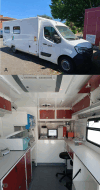Validation of a mobile clinical pathology laboratory for canine hematology and biochemistry
- PMID: 40264110
- PMCID: PMC12013186
- DOI: 10.1186/s12917-025-04601-6
Validation of a mobile clinical pathology laboratory for canine hematology and biochemistry
Abstract
Background: In clinical diagnosis and research, it is often essential to carry out laboratory tests that provide reliable results rapidly. However, in some circumstances, these tests are not available at the patient's location, leading to a delay before analysis that increases turnaround time and can cause pre-analytical errors. To this end, a new mobile laboratory van containing one hematology and one biochemistry benchtop analyzers was developed, and a validation study was performed under field conditions (i.e., after trips of varying distances) with canine specimens and quality control materials.
Results: Linearity was considered acceptable for all variables. Coefficient of variation was < 5% for biochemical variables and most hematological ones (0.0-8.11%) and imprecision was in line with the recommendations for all variables except for neutrophil count in the short-term imprecision. Observed total error for albumin with the quality control material was higher than allowable total error, secondary to a high bias. The comparison with the same model of analyzer showed significant bias for nearly all variables but observed total error remained lower than acceptable total error for all variables except for lymphocyte and reticulocyte counts.
Conclusion: Both analyzers exhibited acceptable performance in the mobile laboratory operating conditions, making them suitable for future use in the field.
Keywords: Benchtop analyzer; Biochemistry; Canine; Hematology; Laboratory van; Mobile laboratory; On-field; POCA; Validation study.
© 2025. The Author(s).
Conflict of interest statement
Declarations. Ethics approval and consent to participate: This study was approved by the “Science et Santé animale” Ethics Committee (N° SSA_2023_023). Comité d’éthique en expérimentation animale SCIENCE ET SANTE ANIMALES N°115 Ecole Nationale Vétérinaire 23 chemin des Capelles BP 87614 31076 TOULOUSE cedex 3, France. Informed consent was obtained from owners for the use of blood specimen from their dogs. Consent for publication: Not applicable. Competing interests: The authors declare no competing interests. Duplicate publication: Oral presentation presented at, and abstract published in proceedings of, the Congress of the European Society of Veterinary Clinical Pathology, August 2024 at Budapest, Hungary.
Figures



Similar articles
-
Validation of the Sysmex XN-V hematology analyzer for canine specimens.Vet Clin Pathol. 2021 Jun;50(2):184-197. doi: 10.1111/vcp.12936. Epub 2021 Jun 21. Vet Clin Pathol. 2021. PMID: 34152026 Free PMC article.
-
Precision and accuracy of the Mindray BC-5000Vet hematology analyzer for canine and feline blood.Vet Clin Pathol. 2020 Jun;49(2):207-216. doi: 10.1111/vcp.12861. Epub 2020 Jun 10. Vet Clin Pathol. 2020. PMID: 32524640
-
Objective evaluation of analyzer performance based on a retrospective meta-analysis of instrument validation studies: point-of-care hematology analyzers.Vet Clin Pathol. 2017 Jun;46(2):248-261. doi: 10.1111/vcp.12492. Epub 2017 May 3. Vet Clin Pathol. 2017. PMID: 28467597
-
Evaluation of canine and feline leukocyte differential counts obtained with the scil vCell 5 compared to the Advia 2120 hematology analyzer and a manual method.J Vet Diagn Invest. 2023 Nov;35(6):679-697. doi: 10.1177/10406387231187899. Epub 2023 Aug 23. J Vet Diagn Invest. 2023. PMID: 37612877 Free PMC article. Review.
-
Perspectives and advances in in-clinic laboratory diagnostic capabilities: hematology and clinical chemistry.Vet Clin North Am Small Anim Pract. 2007 Mar;37(2):221-36, v. doi: 10.1016/j.cvsm.2006.11.005. Vet Clin North Am Small Anim Pract. 2007. PMID: 17336672 Review.
References
-
- Fujino Y, Nakamura Y, Matsumoto H, Fukushima K, Takahashi M, Ohno K, et al. Development and evaluation of a novel in-clinic automated hematology analyzer, ProCyte Dx, for canine erythrocyte indices, leukogram, platelet counts and reticulocyte counts. J Vet Med Sci. 2013;75(11):1519–24. - PMC - PubMed
-
- Goldmann F, Bauer N, Moritz A. Evaluation of the IDEXX ProCyte Dx analyzer for dogs and cats compared to the Siemens ADVIA 2120 and manual differential. Comp Clin Pathol. 2014;23:283–96.
Publication types
MeSH terms
LinkOut - more resources
Full Text Sources

